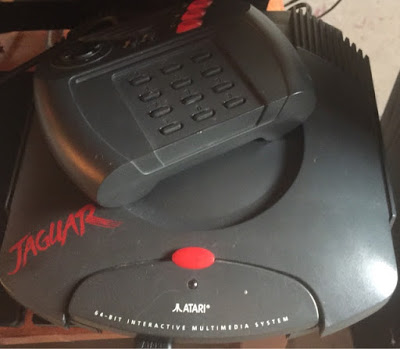Despite, how many gamer’s have painted the Atari Jaguar over the years as a slow and outdated machine at its release, I’ve found it to be the exact opposite. Atari made the Jaguar to perform like a finely tuned roadster in a world of mini-vans, and they succeeded. If they hadn’t, than I seriously doubt that Sega would have made the Saturn to compete against it, rather than the against their old rival Nintendo and it’s N64. The Jaguar was a competitor and serious one at that, but times had changed for Atari as a company, and memories of the Atari 7800’s dismal performance against the NES, still haunted the consumer market. Gamers wanted names like Sega, and Nintendo on their consoles, not blasts from the past like Atari and for that the Jaguar suffered, and was even ridiculed.
I will say that the Jaguar had it’s issues, after all it is a 32-bit machine, and as we know with the Saturn, PS1, and N64, games of the 32-bit era haven’t exactly aged well. You also have to keep in mind those three respective systems came two additional years after the Jaguar. In essence the Jaguar was among the first of the so called 32/64-bit machines, and with that said it’s only true competitors in 1993 were the oddball 3DO, and CD-i both of which had bigger issue than just their graphics. This was after all the era of the first polygonal games, sure the SNES had put such games out there with Star Fox, and Vortex, but the next generation of consoles would be the true proving grounds for such games and the Jaguar was the vanguard. When many criticize games on the Jaguar they often cite these early polygonal’s as proof of the Jaguars inferiority, despite that fact that not even the PS1 in its early years could do any better. One such game often criticized, ridiculed, and given as an example of how bad the Jaguar was is Cybermorph, a game those who have never played it wouldn’t understand.
Cybermorph even though it has the look of a Star Fox clone is surprisingly good. The game is based on free flight rather than being a rail-shooter like Star Fox. It’s polygonal graphics really failed to show the systems capabilities though, and did give it the look of a Star Fox clone to the casual observer. To be honest my initial opinion of the game was derived from watching the AVGN, and I also expected to be annoyed to the point of wanting to throwing my controller across the room by my bald green AI friend. Much to my surprise though, I didn’t see her once, so either I’m a better pilot than the AVGN, or he just crashed his fighter into as many things as possible for maximum comic effect, which seems more likely. Overall though I found game play to be fun and entertaining, despite feeling totally lost as to what my mission objectives where suppose to be. To be honest though the early polygonal graphics ultimately didn’t bother me, since the game played smoothly and rendered the 3D objects in the game fairly solidly. This could also be said of a lot of the other polygonal titles on the Jaguar, although there are some exceptions like Club Drive, and Checkered Flag which albeit fun can be hard on the eyes at times, and full of unstable polygonal shapes.
Before becoming an Atari Jaguar owner myself, I had always heard about how Atari Jaguar owners where protective over their system, and always apt to defend it, I can now see why that is. The Jaguar is a system that had a lot of potential but was never able to really live up to that due to Nintendo’s chock-hold on the many third party developers, even into the era of the SNES. On top of that critics of the era and even now, have always been willing to throw the Jaguar under the bus when it came to saying something good about the system in comparison to those of Sega or Nintendo. Many fail to realize that the Jaguar, even though it claimed to be a 64-bit system, was still a 32-bit system in an era where 32-bit wasn’t a thing, this was after all a full year before Sega could make that claim with their 32x, and two years before the first mainstream systems arrived on the scene. In an era when the old systems are starting to re-emerge, I hope that the Jaguar gets a second chance at proving itself as well as telling it’s story.
As for me since buying my system last year I have bought a few new Jaguar games into the fold, but its been slow going due to the price of Jaguar games, which seem to average around $30+ a piece, and even more for the exceptionally good ones. Of course I have been guided towards some of the better games by Shinto’s Atari Jaguar Game by Game Podcast which I started listening to in October of 2015. This podcast has been a great resource for me in learning about the Jaguar and its games, as well as the community around it and the some of the system and game history. If you have an interest in the Atari Jaguar it may be something you want to check out.
If your interested in getting an Atari Jaguar (cartridge), the systems are currently going for an average of about $170-$180, which is almost as much as they cost new.The Atari Jaguar CD, the later add on to the main system, is selling for an average of about $500 on eBay, but I’ve seen them cheaper elsewhere. As for the games, as previously mentioned, they run upwards of an average of $30, and titles like Raiden, Alien Vs Predator, and Tempest 2000 will obviously go for more.



